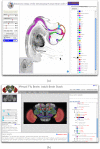Web tools for large-scale 3D biological images and atlases
- PMID: 22676296
- PMCID: PMC3412715
- DOI: 10.1186/1471-2105-13-122
Web tools for large-scale 3D biological images and atlases
Abstract
Background: Large-scale volumetric biomedical image data of three or more dimensions are a significant challenge for distributed browsing and visualisation. Many images now exceed 10GB which for most users is too large to handle in terms of computer RAM and network bandwidth. This is aggravated when users need to access tens or hundreds of such images from an archive. Here we solve the problem for 2D section views through archive data delivering compressed tiled images enabling users to browse through very-large volume data in the context of a standard web-browser. The system provides an interactive visualisation for grey-level and colour 3D images including multiple image layers and spatial-data overlay.
Results: The standard Internet Imaging Protocol (IIP) has been extended to enable arbitrary 2D sectioning of 3D data as well a multi-layered images and indexed overlays. The extended protocol is termed IIP3D and we have implemented a matching server to deliver the protocol and a series of Ajax/Javascript client codes that will run in an Internet browser. We have tested the server software on a low-cost linux-based server for image volumes up to 135GB and 64 simultaneous users. The section views are delivered with response times independent of scale and orientation. The exemplar client provided multi-layer image views with user-controlled colour-filtering and overlays.
Conclusions: Interactive browsing of arbitrary sections through large biomedical-image volumes is made possible by use of an extended internet protocol and efficient server-based image tiling. The tools open the possibility of enabling fast access to large image archives without the requirement of whole image download and client computers with very large memory configurations. The system was demonstrated using a range of medical and biomedical image data extending up to 135GB for a single image volume.
Figures










References
-
- Goldberg IG, Allan C, Burel JM, Creager D, Falconi A, Hochheiser H, Johnston J, Mellen J, Sorger PK, Swedlow JR. The open microscopy environment (OME) data model and XML file: open tools for informatics and quantitative analysis in biological imaging. Genome Biology. 2005;6(5):R47. doi: 10.1186/gb-2005-6-5-r47. - DOI - PMC - PubMed
-
- I3A. Internet imaging protocol. 1997.
-
- della Mea V, Roberto V, Beltrami CA. 5th Int’l Conf. on Information Visualization. , ; 2001. Visualization issues in telepathology: The role of the internet imaging protocol; pp. 717–722.
Publication types
MeSH terms
Grants and funding
LinkOut - more resources
Full Text Sources

